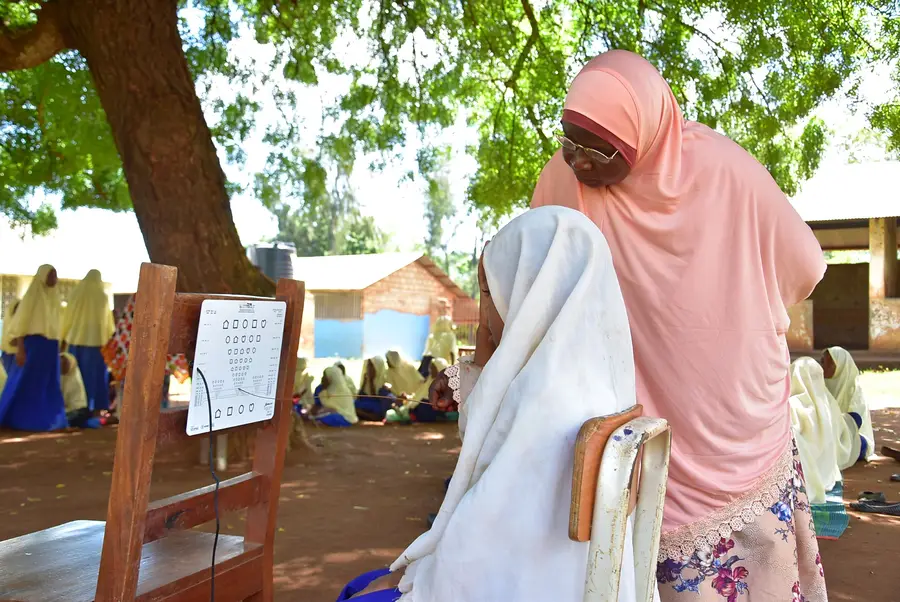
Vision screening at a school in Zanzibar, Tanzania. Photo credit: USAID/Tanzania Hesabu na Elimu Jumuishi (Arithmetic and Inclusive Education) Activity
In an overcrowded classroom in Uganda, Lydia, a first-grade teacher, slowly makes her way through a crowded room of 150 students who are all sitting on the floor. She is tasked with providing quality instruction for all of them, including those with disabilities. But how can she do this when she can barely walk through the room, has few teaching materials, and has never received training on inclusive instruction?
This is the challenge that many teachers in low-income countries face. With under-resourced schools and large numbers of students with varying abilities in their classes, teachers often find themselves underprepared and ill-equipped to provide the level of quality and individualized instruction needed to help all their students thrive.
The realities faced by Lydia and many others like her underscore the need for broad adoption of and support for inclusive education. Countries around the world largely share the aspiration to provide quality, inclusive education to all children regardless of ability. However, many struggle with how best to do so for the most vulnerable children and their families, and at the most local level.
Education that is truly inclusive of children with disabilities must be designed in partnership with those children, their families, and the communities that surround them. With an estimated 15 percent of the world’s population having a disability, people with disabilities—children included— are not a fringe group and cannot be ignored if a country wants to achieve its economic and social goals. In this blog post, we explore the topic of inclusive education for children with disabilities and how implementing partners, particularly international organizations, need to collaborate with local partners to realize it.
What is Inclusive Education?
Inclusive education provides quality education for all students, regardless of ability, and “allows students of all backgrounds to learn and grow side by side, to the benefit of all” (UNICEF). It encompasses disability inclusion, recognizing that students’ needs vary and that finding ways to meet these needs is essential to building an informed, educated, and productive citizenry.
Inclusive education systems recognize the rights and dignity of all individuals, ensuring no one is left behind. These systems set expectations and provide guidance for how to adjust education delivery to maximize learning outcomes for students with diagnosed disabilities, as well as those who are struggling but have not been diagnosed as having a disability.
Inclusive education embraces classroom management strategies that are grounded in Universal Design for Learning and social inclusion best practices, allowing students to be taught in and to respond in ways that are most appropriate for them. This can include providing books in large print or, as RTI has done in Cambodia, giving teachers innovative tools, such as sensory stories, which include things to do, touch, smell, hold, or listen to, and make learning more engaging for all students, particularly those with disabilities.
What Are Some Examples of Inclusive Education?
At the systems level, inclusive education ensures that all students can be screened for vision, hearing, and learning disabilities and that formal assessments—such as end-of-grade evaluations that determine progression to the next grade—are equitable and accessible for all students. Inclusive education systems also ensure that physical school environments allow all students to move freely and engage in all activities both in and out of the classroom. This goes beyond installing ramps, and includes ensuring classrooms, bathrooms, and other structures are accessible for children with limited mobility.
At the school and classroom levels, adaptive strategies and assistive technologies can be used in support of inclusive education. In Ethiopia, from 2016 to 2017, READ TA: the Reading for Ethiopia’s Achievement Developed—Technical Assistance project worked with local associations for the blind, deaf, and persons with disabilities to identify and implement smartphone-based screening tools for vision and hearing impairment, and helped the project tailor tools and support to meet the needs of children with disabilities. Since then, assessment and instructional support tools, like RTI’s Tangerine:Teach, have been helping teachers identify students who are struggling and provide feedback on teaching strategies to address their students’ learning needs.
How Can Families and Communities Be Engaged to Enhance Inclusive Education?
Inclusive education systems must partner with local leaders, parents, and families to reduce the stigma that often surrounds disability and to raise awareness that children with disabilities need to attend school. In Bangladesh, for example, through the USAID Shobai Miley Shikhi (“Everyone Learns Together”) project, RTI has trained a cadre of school community facilitators to implement a campaign designed to foster inclusive education through parent meetings, community courtyard meetings, and inclusion fairs.
Community advocacy should also engage community members directly as resource providers. For example, through the USAID All Children Learning project in Cambodia, RTI worked with the Ministry of Education, Youth, and Sport in developing a national guide for screening and referrals—a tool that civil society organizations can use to screen children for disabilities and refer them for additional testing and support when it is needed.
RTI also trained local volunteers as Cambodian Sign Language (CSL) coaches, who then taught CSL to children who are deaf. These volunteers helped create peer support groups that served as resources for families with children that have developmental delays and disabilities. By working with these community members, the project was able to draw directly on existing capacity with the aim of co-creating lasting solutions.
How Can Implementing Partners Support Locally Led Inclusive Education for Children With Disabilities?
Truly inclusive education is informed by local needs and voices, designed with local stakeholders, and implemented using sound local solutions. As implementing partners, we need to work to understand and incorporate local dynamics and perspectives. This should include listening to the voices of individuals with disabilities to identify needs; partnering with local organizations and stakeholders that serve people with disabilities in decision-making, design, implementation, and monitoring; providing the tools, resources, and capacity building they require; and learning from and with them.
Further, implementing partners can take the following steps to ensure that inclusive education initiatives are locally led:
- Make disability inclusion a cross-cutting theme across activities.
- Recognize and tap the expertise of local people with disabilities and organizations of people with disabilities.
- Create a level playing field in recruiting staff and consultants, to intentionally encourage people with disabilities to apply and to explicitly remove barriers that prevent them from doing so.
- Be aware of intersectionality, recognizing how disability intersects with other forms of marginalization and taking care to do no harm to any population group.
- Budget for inclusion, including for accommodations and to compensate local stakeholders and organizations for their time.
- Ensure that all communications—internal and external—are respectful of people with disabilities and tailored to meet their needs.
The Future of Inclusive Education Systems & Locally Led Development
Inclusive education systems should be, at their core, locally led. Inclusion is most powerful when those who are traditionally excluded are at the forefront of defining their own challenges and identifying and helping implement solutions. And inclusive education interventions are most effective when they work with children, their families, and the local organizations that support them.
In the effort to provide quality inclusive education globally, locally led development is not just an aspiration but an imperative, and it must begin with and be led by people with disabilities. By embracing the mantra of “nothing about us without us” and prioritizing their voices and experiences, we can help to ensure that development efforts are not only more appropriate and respectful but also more effective.
Learn more about RTI’s commitment to locally led development and our work in international education.


